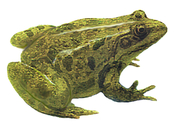|
Description
This species is morphologically very similar to the Marsh Frog (R. ridibunda). Snout relatively sharp. Eyes small: their diameter is comparable to the diameter of tympanum. Inner metatarsal tubercle small, 2.3-3.8 mm. Ratio first toe/inner metatarsal tubercle 3.8-5.0. Male resonators dark-gray. Green tints prevail in dorsal coloration. Dark-brown spots of the dorsal pattern less numerous than in the Marsh Frog; light mid-dorsal line exist in all individuals Distribution and Habitat
Country distribution from AmphibiaWeb's database: China, Tajikistan
The species inhabits plains and mountain areas of Southern Tajikistan (southerly from the Gissar Ridge): environs of settlements Obi-Garm, Shaartuz, probably near Dushanbe City and other areas. It probably also lives in the lower reaches of the Amu-Darya River and in Northern Afghanistan. In the valley near Obi-Garm Settlement, the species was recorded in puddles and swamps near warm springs.Life History, Abundance, Activity, and Special Behaviors
In all probability, it is not a rare species. The frogs, earlier identified as Rana ridibunda, are known to be common in the rivers of southern Tajikistan. Nevertheless, ecological data on frogs identified as R. terentievi are very scarce. In the valley near Obi-Garm Settlement, the hibernation finishes probably in April. In the valley of the Vakhsh River, the hibernation is finished in late February - early March. Frogs hibernate on land: in holes, old tree roots and in rodent burrows. It should be noted that the terrestrial hibernation of the relative species, R. ridibunda is known in different parts of its range. Reproduction takes place in March. The frog feeds on insects and, in fisheries, fish fry. Relation to Humans
The frog does not avoid anthropogenic landscapes. In particular, it occurs in fisheries. Comments
Rana ridibunda is considered now as a complex of species, whose study is in progress. Morphological differences of R. terentievi and R. ridibunda sensu stricto are unstable, and the species status was determined on the basis of genetic differences. The genetic distance between R. ridibunda and R. terentievi (D = 0.293) is comparable to that between other studied species of this complex. Therefore, according to the current taxonomy of these frogs, R. terentievi should be of the same validity as other species of this complex. However, a final decision on its status can be made only after complex taxonomic revision of the Rana ridibunda group.
References
Kuzmin, S. L. (1999). The Amphibians of the Former Soviet Union. Pensoft, Sofia-Moscow.
Mezhzherin, S.V. (1992). ''A new species of green frogs Rana terentievi sp. nova (Amphibia, Ranidae) from South Tadjikistan.'' Doklady Akademii Nauk Ukrainskoi SSR, Matematicheskie, Estestvennye, Tekhnicheskie Nauki (in Russian)., 1992(5), 150-153.
Mezhzherin, S.V. and Peskov, V.N. (1992). "Biochemical variability and genetic differentiation of Rana ridibunda populations." Tsitologiya i Genetika (in Russian)., 26(1), 43-48.
Said-Aliev, S.A. (1979). Amphibians and Reptiles of Tajikistan (in Russian). Dushanbe: Donish.
Originally submitted by: Sergius L. Kuzmin (first posted 2000-01-21)
Edited by: Vance T. VredenburgSpecies Account Citation: AmphibiaWeb 2000 Pelophylax terentievi: Terentjev's Frog <https://amphibiaweb.org/species/5292> University of California, Berkeley, CA, USA. Accessed May 29, 2025.
Feedback or comments about this page.
Citation: AmphibiaWeb. 2025. <https://amphibiaweb.org> University of California, Berkeley, CA, USA. Accessed 29 May 2025.
AmphibiaWeb's policy on data use.
|




 Map of Life
Map of Life